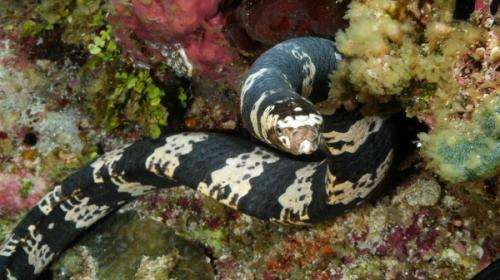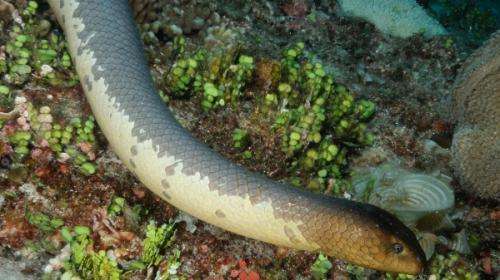The researcher found two snakes (Emydocephalus annulatus) at Echuca Shoal and Heyward Shoal as part of their survey. Credit: WA Museum
A recent survey of four submerged shoals off the Kimberley coast turned up three species of sea snake while a search farther north at Ashmore Reef, a former sea snake "hot spot", failed to reveal any specimens.
WA Museum marine biologist Glenn Moore says this was the first ever biological survey of the shoals.
They found Emydocephalus annulatus at Echuca Shoal (two individuals) and Heyward Shoal (one individual); Aipysurus laevis at Heywood, Eugene-McDermott and Vulcan Shoals (one individual at each); and the Australasian endemic Aipysurus duboisii at Vulcan Shoal (two individuals).
"We noted in the literature there has been this really obvious decline in sea snakes in the North West Shelf," he says.
"Traditionally we've known that on a global scale, they're the hot spots for these sea snakes."
The study follows a 2010 trip to Ashmore Reef in which marine herpetologist Vimoksalehi Lukoschek found just two species represented in very small numbers.
Dr Moore says he swam time-based transects at a set speed for a given time period, recording any snakes he saw.
The 14 other researchers on the boat also kept an eye out for sea snakes as they surveyed other taxa.
He says the data he gathered may be useful to future researchers trying to ascertain what caused sea snake numbers to decline.
"One of the things about the decline is that we don't know the causes of it, therefore we don't know the opportunities for recovery from it," he says.
Aipysurus laevis snakes were found at Heywood, Eugene-McDermott and Vulcan Shoals. Credit: WA Museum
It may also provide some clue as to what conditions the snakes need to repopulate.
"If it's a reversible trend we don't know, so part of that is gathering as much information as we can on the biology of these animals which includes their distribution," Dr Moore says.
He says the shoals are permanently under at least 20 metres of water, forcing the snakes to hunt at a depth.
However they are known to generally thrive in semi-submerged tidal reef conditions.
He conducted this research with marine biologist Dr Zoe Richards, who led a 2009 expedition, and a team of scientists organised by the WA Museum.
The trip was part of a six-year marine life survey by the museum of the Kimberley coast and offshore areas.
They have been surveying and collecting taxa including fish, corals, sponges, mussels, echinoderms, crustacean, seaweeds, and worms.
They are now departing for Rowley Shoals, in what will be the final trip.
More information: G. I. Moore, Z. T. Richards. "New records of sea snakes at mid-shelf shoals of Australia's North West Shelf." Marine Biodiversity, 12 Sep 2014. DOI: 10.1007/s12526-014-0267-7
Provided by Science Network WA






















